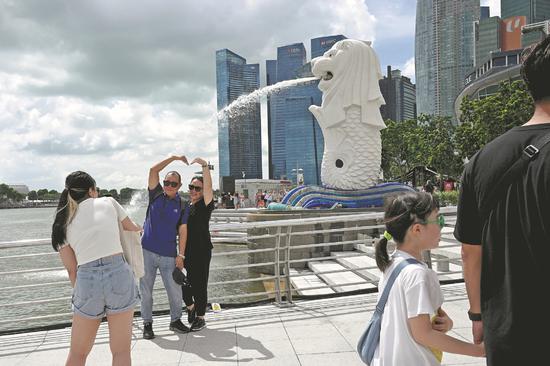2024-04-01 China Daily Editor-in-Chief: Li Yan
Industry recovers from recession, growth driven by Chinese spending habits
Analysts say an influx of Chinese travelers over the past few months has helped Southeast Asia’s tourism industry recover from the pandemic-induced downturn.
China has long been a key travel market for Association of Southeast Asian Nations (ASEAN) member states, but decisions by Singapore, Malaysia and Thailand last year to waive entry requirements for Chinese tourists boosted tourism receipts in the first two months of this year.
John Paolo Rivera, deputy director of the Andrew L. Tan Tourism Center at the Asian Institute of Management in the Philippines, said visa-free entry for Chinese tourists was a “catalyst” for increased revenue for ASEAN’s tourism industry.
Rivera said Chinese tourists are the biggest spenders among Southeast Asian travelers.
“The number of Chinese tourists as well as their spending habits are boosting tourism’s contribution to Southeast Asia’s consumer spending and GDP,” he said, noting that tourist spending is helping Asean’s travel industry recover from losses suffered during the pandemic.
Perhaps Chinese tourist spending has the biggest impact on Singapore.
Official statistics show that 13.6 million international tourists visited the city-state last year, with China among its top three destinations. Tourism receipts in the first nine months of last year reached $15 billion, with Chinese tourists spending more than $1.7 billion, making them the largest spenders, according to the Singapore Tourism Board.
Flight Connections
The committee expects the tourism sector’s recovery to continue this year thanks to improving global air connectivity and the implementation of 30-day reciprocal visa-free travel between China and Singapore, which began on February 9.
Yu Hong, a senior research fellow at the National University of Singapore’s East Asia Institute, said the reciprocal visa waiver agreement had increased the number of Chinese tourists visiting Singapore, especially during the Chinese New Year period.
Singapore has always been a popular destination among Chinese tourists due to its geographical proximity, cultural similarities and the availability of direct flights to Chinese cities, Yu said.
In Malaysia, authorities welcomed passengers on board China Eastern Airlines’ inaugural flight from Kunming, Yunnan province, to the Malaysian capital, Kuala Lumpur, on March 16.
Malaysian Tourism Promotion Board director general Manoharan Periasamy said in a statement that the new route presents a “golden opportunity” to attract more Chinese tourists, especially after the visa waiver policy came into effect on December 1.
This year, Malaysia is expecting 27.3 million international tourist arrivals, of which 5 million are expected to be from China.
Meanwhile, Thai government spokesman Chai Watcharoenkae was quoted in media as saying that 3.96 million foreign tourists visited Thailand between Jan. 1 and Feb. 8, of which 730,747 were from China, topping the list.
According to online travel agency Trip.com, the number of Chinese tourists visiting Thailand as of March 1 was up more than 30 percent compared to the same period last year, according to Xinhua News Agency.
Qin Jing, vice president of Trip.com Group, said the implementation of mutual visa exemptions in March will have a very positive impact on the growth of tourism in both countries.

Copyright © 1999-2024 Chinanews.com All rights reserved.

